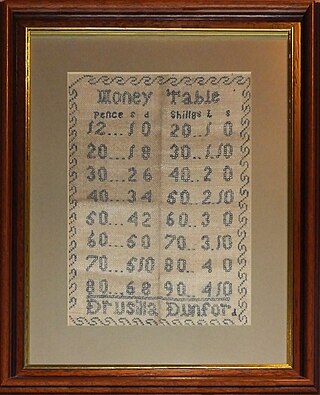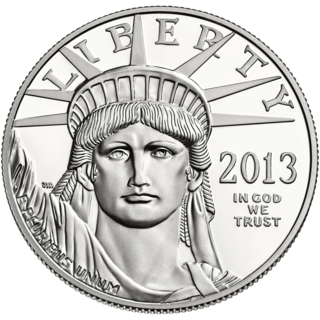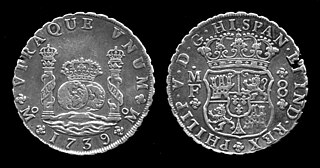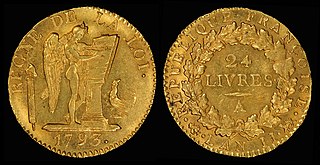
The shilling is a historical coin, and the name of a unit of modern currencies formerly used in the United Kingdom, Australia, New Zealand, other British Commonwealth countries and Ireland, where they were generally equivalent to 12 pence or one-twentieth of a pound before being phased out during the 1960s and 1970s.
Decimalisation or decimalization is the conversion of a system of currency or of weights and measures to units related by powers of 10.

The guinea was a coin, minted in Great Britain between 1663 and 1814, that contained approximately one-quarter of an ounce of gold. The name came from the Guinea region in West Africa, from where much of the gold used to make the coins was sourced. It was the first English machine-struck gold coin, originally representing a value of 20 shillings in sterling specie, equal to one pound, but rises in the price of gold relative to silver caused the value of the guinea to increase, at times to as high as thirty shillings. From 1717 to 1816, its value was officially fixed at twenty-one shillings.

Sterling is the currency of the United Kingdom and nine of its associated territories. The pound is the main unit of sterling, and the word "pound" is also used to refer to the British currency generally, often qualified in international contexts as the British pound or the pound sterling. In British English, its most common nickname is "quid".
The mill or mil is a unit of currency, used in several countries as one-thousandth of the base unit. In the United States, it is a notional unit equivalent to a thousandth of a United States dollar. In the United Kingdom, it was proposed during the decades of discussion on decimalisation as a 1⁄1000 division of sterling's pound. While this system was never adopted in the United Kingdom, the currencies of some British or formerly British territories did adopt it, such as the Palestine pound and the Maltese lira.

The mark was a currency or unit of account in many states. It is named for the mark unit of weight. The word mark comes from a merging of three Germanic words, Latinised in 9th-century post-classical Latin as marca, marcha, marha or marcus. It was a measure of weight mainly for gold and silver, commonly used throughout Europe and often equivalent to 8 troy ounces (250 g). Considerable variations, however, occurred throughout the Middle Ages.

The solidus or nomisma was a highly pure gold coin issued in the Late Roman Empire and Byzantine Empire. The early 4th century saw the solidus introduced in mintage as a successor to the aureus, which was permanently replaced thereafter by the new coin, whose weight of about 4.5 grams remained relatively constant for seven centuries. In the Byzantine Empire, the solidus, or nomisma, remained a highly pure gold coin until the 11th century, when several Byzantine emperors began to strike the coin with less and less gold. The nomisma was finally abolished by Alexius I in 1092, who replaced it with the hyperpyron, which also came to be known as a "bezant". The Byzantine solidus also inspired the originally slightly less pure dinar issued by the Muslim Caliphate. In Western Europe, the solidus was the main gold coin of commerce from late Roman times to Pepin the Short's currency reform in the 750s, which introduced the silver-based pound/shilling/penny system.

£sd, spoken as "pounds, shillings and pence", is the popular name for the pre-decimal currencies once common throughout Europe. The abbreviation originates from the Latin currency denominations librae, solidi, and denarii. In the United Kingdom, these were referred to as pounds, shillings, and pence.

The Coinage Act of 1792, passed by the United States Congress on April 2, 1792, created the United States dollar as the country's standard unit of money, established the United States Mint, and regulated the coinage of the United States. This act established the silver dollar as the unit of money in the United States, declared it to be lawful tender, and created a decimal system for U.S. currency.

The pound was the currency of Australia from 1910 until 14 February 1966, when it was replaced by the Australian dollar. Like other £sd currencies, it was subdivided into 20 shillings, each of 12 pence.

The American Gold Eagle is an official gold bullion coin of the United States. Authorized under the Gold Bullion Coin Act of 1985, it was first released by the United States Mint in 1986. Because the term "eagle" also is the official United States designation for pre-1933 ten dollars gold coins, the weight of the bullion coin is typically used when describing American Gold Eagles to avoid confusion. This is particularly true with the 1/4-oz American Gold Eagle, which has a marked face value of ten dollars.

The American Platinum Eagle is the official platinum bullion coin of the United States. In 1995, Director of the United States Mint Philip N. Diehl, American Numismatic Association President David L. Ganz, and Platinum Guild International Executive Director Jacques Luben began the legislative process of creating the Platinum Eagle. After over two years of work, the 99.95% fine platinum coins were released by the United States Mint in 1⁄10, 1⁄4, 1⁄2 and 1 troy oz denominations. In late 2008, the fractional denominations were discontinued, leaving only the one ounce denomination. The Platinum Eagle is authorized by the United States Congress, and is backed by the United States Mint for weight, content, and purity.

The silver standard is a monetary system in which the standard economic unit of account is a fixed weight of silver. Silver was far more widespread than gold as the monetary standard worldwide, from the Sumerians c. 3000 BC until 1873. Following the discovery in the 16th century of large deposits of silver at the Cerro Rico in Potosí, Bolivia, an international silver standard came into existence in conjunction with the Spanish pieces of eight. These silver dollar coins played the role of an international trading currency for nearly four hundred years.
The history of money is the development over time of systems for the exchange, storage, and measurement of wealth. Money is a means of fulfilling these functions indirectly and in general rather than directly, as with barter.
The maravedí or maravedi, , was the name of various Iberian coins of gold and then silver between the 11th and 14th centuries and the name of different Iberian accounting units between the 11th and 19th centuries.

The livre was the currency of Kingdom of France and its predecessor states of Francia and West Francia from 781 to 1794. Several different livres existed, some concurrently. The livre was the name of coins and of units of account.

Money is any item or verifiable record that is generally accepted as payment for goods and services and repayment of debts, such as taxes, in a particular country or socio-economic context. The primary functions which distinguish money are: medium of exchange, a unit of account, a store of value and sometimes, a standard of deferred payment.

The United States dollar is the official currency of the United States and several other countries. The Coinage Act of 1792 introduced the U.S. dollar at par with the Spanish silver dollar, divided it into 100 cents, and authorized the minting of coins denominated in dollars and cents. U.S. banknotes are issued in the form of Federal Reserve Notes, popularly called greenbacks due to their predominantly green color.

Italy has a long history of different coinage types, which spans thousands of years. Italy has been influential at a coinage point of view: the medieval Florentine florin, one of the most used coinage types in European history and one of the most important coins in Western history, was struck in Florence in the 13th century, while the Venetian sequin, minted from 1284 to 1797, was the most prestigious gold coin in circulation in the commercial centers of the Mediterranean Sea.
The one rin coin (一厘銅貨) was a Japanese coin worth one one-thousandth of a Japanese yen, as 10 rin equalled 1 sen, and 100 sen equaled 1 yen. The coins are no longer in circulation, but they are bought and sold both by professional numismatists and by amateur coin collectors.














